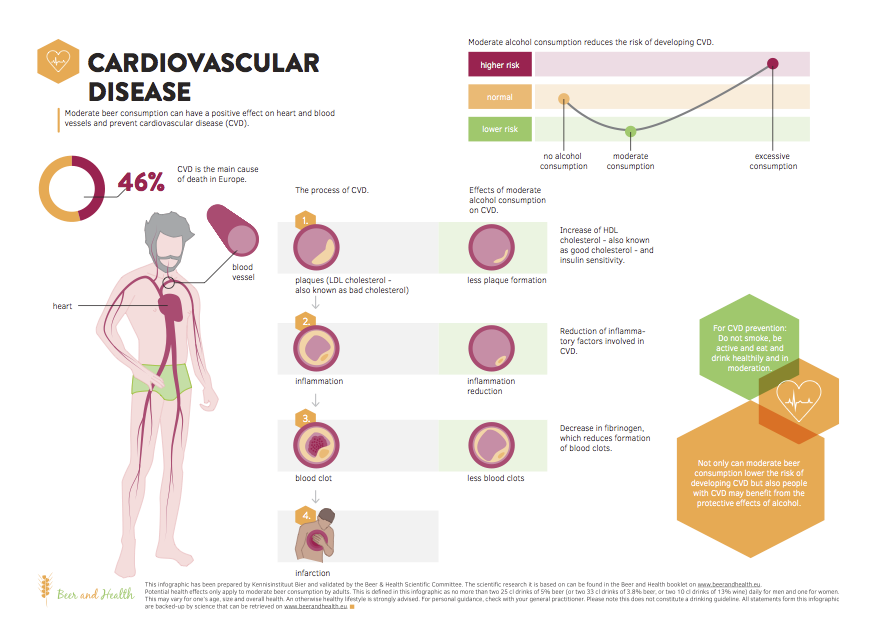A recently published meta-analysis1 in BMC Public Health tries to assess whether the protective effects of alcohol consumption on cardiovascular disease are true for people living in community settings. Results show the traditional J-curve with protective effects of moderate alcohol consumption for men. However, no protective effects are found for men with three or more comorbidities and people younger than 40 years.
What is already known? After years of research, the scientific evidence that there is a J-shaped association between alcohol consumption and risk of cardiovascular disease (CVD) is quite strong. With an alcohol consumption of 15-30 grams a day, the risk of CVD is at its lowest, with a 25% lower risk compared to abstainers2, but the risk is still low at intakes up to 60 grams a day. Studies looking at the physical response due to alcohol consumption support the existence of a causal relation.
What does this study add? This study focusses on residents from local communities and tests whether there are individual differences in alcohol effect due to gender, age and number of comorbidities.
This meta-analysis includes seven cohort and cross-sectional studies performed in local communities in among others Japan, Australia, Canada and the United States. In total, almost 150.000 people are included in the analysis.
Lower risk for men drinking in moderation
Data show the well-known J-shaped relation for men; light to moderate drinking, so one to four glasses a day, is associated with a 20 to 25% lower risk of CVD compared to non-drinking. For higher alcohol consumption the risk increases again, although the risk never exceeds that of non-drinking. For men with more than three comorbidities, the risk did increase after six alcoholic consumptions a day.
The authors did not find a protective effect of moderate alcohol consumption in women, but they argue that this is probably due to an insufficient number of women included in the analysis and because women living in the local communities rarely consume more than moderate levels.
Age
Protective effects of moderate alcohol consumption were only found for people above the age of 40, not for younger people. However, this is probably because the risk of CVD is much lower in people under 40, which makes it very difficult to statistically prove an association3.
Mendelian Randomization
Lately, the protective effects of moderate alcohol consumption on cardiovascular diseases are increasingly questioned. This is mostly due to the results of Asian studies that do not classify people based on their reported alcohol consumption, but based on specific genes that influence the alcohol breakdown. This method is called Mendelian Randomization4, and shows no protective effects of alcohol consumption for CVD. This current meta-analysis also starts by questioning the protective effects of alcohol consumption, but results show the well-known J-curve.
Mechanism
The physical mechanism to explain the protective association of moderate alcohol consumption on cardiovascular disease is extensively studied. Several factors support a causal relation between the two, such as the increase of high-density cholesterol (HDL) due to alcohol consumption, a decrease in blood coagulation factors, a reduction in inflammation markers, and improved insulin sensitivity5.
Strengths
- Meta-analysis
Limitations
- Only small number of studies per category included
- Does not look at different cardiovascular diseases such as CHD and stroke
- Not adjusted for sick-quitters
References
1 Yoon, S. J., Jung, J. G., Lee, S., Kim, J. S., Ahn, S. K., Shin, E. S., … & Lim, S. H. (2020). The protective effect of alcohol consumption on the incidence of cardiovascular diseases: is it real? A systematic review and meta-analysis of studies conducted in community settings. BMC Public Health, 20(1), 90.
2 Ronksley PE, Brien SE, Turner BJ et al. (2011). Association of alcohol consumption with selected cardiovascular disease outcomes: a systematic review and meta-analysis. BMJ, 342:d671.
3 Hvidtfeldt, U. A., Tolstrup, J. S., Jakobsen, M. U., Heitmann, B. L., Grønbæk, M., O’Reilly, E., … & Liu, S. (2010). Alcohol intake and risk of coronary heart disease in younger, middle-aged and older adults. Circulation, 121(14), 1589.
4 Wikipedia. Mendelian Randomisation
5 Beer and Health. Beer and cardiovascular disease


